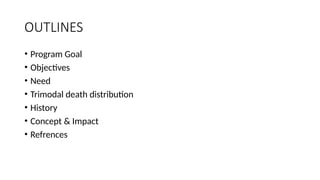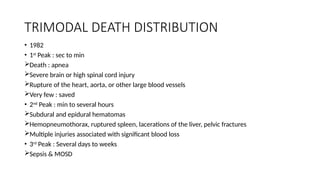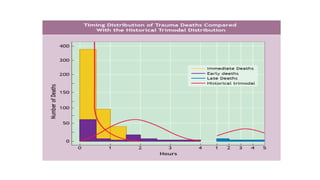ATLS Overview by DR.MUMTAZ ALI NAREJO.pptx
- 1. ATLS COURSE OVERVIEW DR.MUMTAZ ALI NAREJO ASSISSTANT PROFESSOR & INCHARGE NEUROSURGERY DEPARTMENT LIMHS/CIVIL HOSPITAL THATTA
- 2. OUTLINES ŌĆó Program Goal ŌĆó Objectives ŌĆó Need ŌĆó Trimodal death distribution ŌĆó History ŌĆó Concept & Impact ŌĆó Refrences
- 3. PROGRAM GOAL ŌĆó Safe and reliable method : immediate treatment of injured patients ŌĆó Basic knowledge necessary to: ’āśAssess a patientŌĆÖs condition rapidly and accurately ’āśResuscitate & stabilize patients : Priority ’āśPatientŌĆÖs needs > resources of a facility /capability of provider ’āśArrange appropriately for a patientŌĆÖs interhospital or intrahospital transfer. ’āśEnsure that optimal care is provided & level of care does not deteriorate at any point
- 4. OBJECTIVES ŌĆó Content & skills : assist doctors in providing emergency care for trauma ŌĆó ŌĆ£Golden hourŌĆØ : urgency necessary for successful treatment ŌĆó identify & treat : life-threatening & potentially life-threatening injuries ŌĆó Participants will be able to: ’āśDemonstrate the concepts and principles of the primary and secondary assessments ’āśEstablish management priorities in a trauma situation ’āśInitiate primary and secondary management necessary for the emergency management of acute life-threatening conditions in a timely manner ’āśPerform following skills :
- 5. OBJECTIVES ŌĆó Primary and secondary assessment ŌĆó Establishment of a patent airway ŌĆó Initiation of assisted ventilations ŌĆó Orotracheal intubation on adult and infant ŌĆó Pulse oximetry and carbon dioxide detection in exhaled gas ŌĆó Cricothyroidotomy ŌĆó Assessment and treatment of shock
- 6. OBJECTIVES ŌĆó Intraosseous access ŌĆó Pleural decompression via needle or finger & chest tube insertion ŌĆó Recognition of cardiac tamponade and appropriate treatment ŌĆó Clinical and radiographic identification of thoracic injuries ŌĆó Use of peritoneal lavage, FAST, CT in abdominal evaluation ŌĆó Evaluation and treatment of a patient with brain injury (GCS & CT) ŌĆó Protection of the spinal cord & radiographic & clinical evaluation of spine injuries ŌĆó Musculoskeletal trauma assessment & management
- 7. THE NEED ŌĆó WHO & CDC ŌĆó Death : 9/min ŌĆó Death 5.8M/year ŌĆó Burden : 18% ŌĆó MVC : 80%
- 8. TRIMODAL DEATH DISTRIBUTION ŌĆó 1982 ŌĆó 1st Peak : sec to min ’āśDeath : apnea ’āśSevere brain or high spinal cord injury ’āśRupture of the heart, aorta, or other large blood vessels ’āśVery few : saved ŌĆó 2nd Peak : min to several hours ’āśSubdural and epidural hematomas ’āśHemopneumothorax, ruptured spleen, lacerations of the liver, pelvic fractures ’āśMultiple injuries associated with significant blood loss ŌĆó 3rd Peak : Several days to weeks ’āśSepsis & MOSD
- 10. HISTORY ŌĆó Delivery of trauma care : 1980 = Inconsistent ŌĆó Feb 1976 : Tragedy : Rural Nebraska cornfield ŌĆó Plan crash : Orthopedics surgeon with family ŌĆó 1st ATLS course : 1978 ŌĆó Appropriate & timely management reduces morbidity & mortality ŌĆó Course development & dissemination : 1980 ŌĆó International dissemination
- 11. THE CONCEPT & IMPACT ŌĆó Treat the greatest threat to life first ŌĆó Never allow the lack of definitive diagnosis to impede the application of an indicated treatment. ŌĆó A detailed history is not essential to begin the evaluation of a patient with acute injuries ŌĆó Result : ABCDE ŌĆó Impact : mortality & morbidity reduced
- 13. REFRENCES ŌĆó Advance trauma life support student course manual book 10th edition
- 14. THANKYOU













